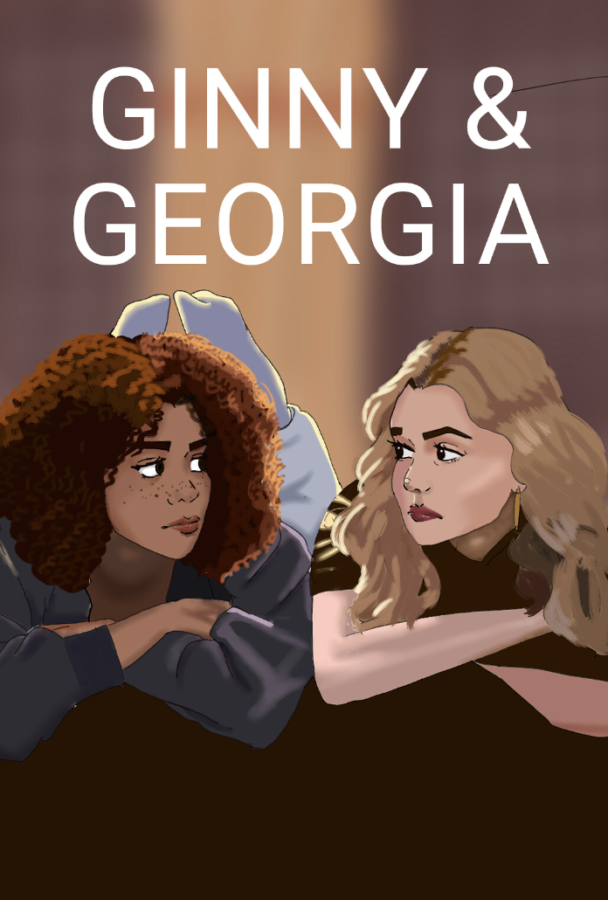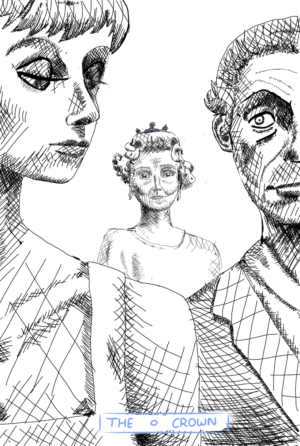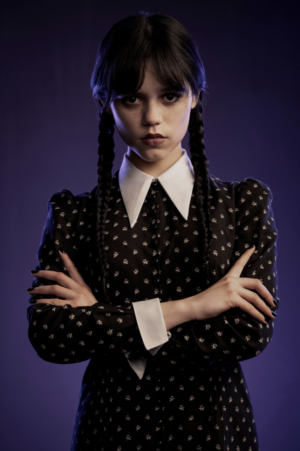Season 2 of “Ginny and Georgia” tells a dismally clichéd story
The second season of Ginny and Georgia hit Netflix on Jan. 5 2023.
January 30, 2023
Note: Spoilers and TW
The highly awaited second season of Netflix show “Ginny & Georgia” debuted in the platform’s top 10 after its Jan 5. release. However, the promised representation of real-world issues was severely lacking.
The comedy-drama series revolves around the relationship between a mother and her daughter, who are involved in a tangled web of drama. It spotlights Georgia, a teenage mother, who struggles to raise her two children, Ginny and Austin, alone while coping with the trauma that her various romantic prospects have brought her. In order to remain financially stable and care for her children, she resorts to pawning off money from the men she was involved with and goes to great lengths to secure an income for her family. The estranged woman and her children head back on the road each time she leaves the man she was entangled with. This becomes a cycle that continues for years until the family arrives in Wellsbury, a fictional town where the series is set.
However, this aspect of Georgia’s personality feels oddly over-exaggerated, as if the producers have tried too hard to push her into the stereotypical “single mother” role. Everything, from her controversial actions, her familial priorities, and her long, emotional monologues, feed into an unrealistic portrayal. True, Brianne Howey plays the part of the unconventional young mother convincingly, but even Georgia’s most outlandish decisions are overlooked in favor of her array of romantic interests and precedences as a mother of two. The viewers’ glorification of Georgia and her decisions are partially to blame as well. Season 2 discloses a great deal of Georgia’s past, however, fans fail to recognize how her mistakes are controversial. Even Georgia murdering her exes does not paint her as a “criminal mastermind” in their eyes. Instead of holding her accountable for how her actions affect her parenting, Georgia rises to the ranks as a fan favorite. Throughout the show, the viewers catch sight of her questionable actions, yet still find a way to love every single one.
Furthermore, the directors focus so much on Georgia’s past that they lose sight of Ginny and Georgia’s present relationship. They prioritize the creation of a plot that includes twists, turns, flashbacks and dramatic chaos, which creates a disregarded and rushed relationship between the duo.
Georgia is not the only character with an overly-stereotyped depiction continuing into Season 2. Twins Marcus and Maxine, Ginny’s boyfriend and best friend respectively, play a pivotal role that adds onto the conventionalized idea of how stereotypes work. Ginny, Austin, and other recurring characters also have cliché-ridden roles which severely limit the potential of the well-developed setting and overall message.
Season 1 shows 15-year-old Ginny as an individual who is struggling with depression and anxiety as a result of her many moves, grim personal life and constant need of validation. This was the real-world representation viewers had been waiting for, and if the producers played their cards right, Ginny’s character could encapsulate the problems that an alarming rate of teenagers around the world struggle with. This was an opportunity for Ginny’s character to break the simplified and over-exaggerated image of mental health in the western media.
But once again, a character’s problems are overshadowed by unsightly clichés. In Season 2, Ginny is forced to give in to the role of a typical movie teenager whose priorities rarely go beyond friends, parties, and the pursuit of romantic relationships. Her struggles are given a few seconds of screen time, and then pushed aside like mere sub-details. Her “teenage life” overshadows the importance of her mental health struggles. This obvious disregard makes it tougher for viewers to relate to the unrealistic show and character.
Like every other teenage lead in mainstream media, Ginny is hardly seen without the people and things that make her bland and predictable: a squad of dramatic friends, a cheesy boyfriend with a penchant for large and unnecessary displays of affection and a notebook in which she writes down her innermost thoughts. It’s surprising her secrets weren’t uncovered more often, given her aptitude for forgetting it in all sorts of places.
A change in seasons brings Ginny a change in boyfriend, but not much more. Ginny’s friend group splits up … and then comes back together after a prolonged period of silent treatment over distorted boy drama. Ginny’s father Zion plays the role of an absentee-turned-involved guardian whose advice rarely seems to reach her ears. Ginny’s brother Austin is a quiet and unproblematic child who only serves as comedic relief and to enhance the emotionality in a scene. Ginny’s new boyfriend is her best friend’s brother – a quiet, mysterious boy, whose struggles with depression and alcoholism are painted over as typical teenage shenanigans. Ginny’s old boyfriend, Hunter, is an Asian-American in their predominantly white school. While the interracial couple’s storyline may have proven interesting, there isn’t a single mention of it throughout the series.
Instead of building each other up, the two characters turn on each other. Certain scenes have raised backlash all over social media. In one such scene, then-couple Ginny and Hunter engage in what they call the “oppression olympics.” Their impending argument leads to a full-blown fight where they resort to stereotyping each other’s races. Their arguments involve hints of racial bias, which is heavily denounced in the current age. It’s hard to imagine why this scene made the cut.
The asperse theme continues with Ginny’s friends. On top of going through a tough time in the aftermath of her parents’ divorce, Abby is struggling with body dysphoria. However, instead of focusing on her feelings and coping mechanisms, the show only depicts her character as a boy-crazy, rule-breaking sidekick. Meanwhile, Maxine is in denial over a failed relationship, which leads to her developing anxiety and severe trust issues. Instead of spotlighting the struggles that make her human, she is only displayed as the loud, outgoing, “friend we love to hate.”
Each and every character is thrown onto a stereotype and not given much more thought. Georgia’s fiancé, Paul, is rendered to a background character without much to do than serve as another trophy in Georgia’s collection of rich, single men. Local restaurant owner Joe, another of Georgia’s potential love interests, is represented as another friendly boy-next-door, who will never make it out of the friend zone. And above it all reign Ginny and Georgia, the unstable mother-daughter duo who make it their mission to constantly invalidate the other’s feelings and problems under the failed label of a misguided relationship.
Ginny and Georgia will never be beacons of hope in a world where mainstream media loves to exaggerate mental health issues and disorders, because the show simply fails to address the importance and relevance of their struggles. By ignoring the characters’ problems, the producers are telling young, impressionable teenagers all over the world that struggling with mental health is “just another part of their life”. And by promoting high school clichés over real-world issues, season 2 of Ginny and Georgia has shown us where the priorities of mainstream media producers really lie.





